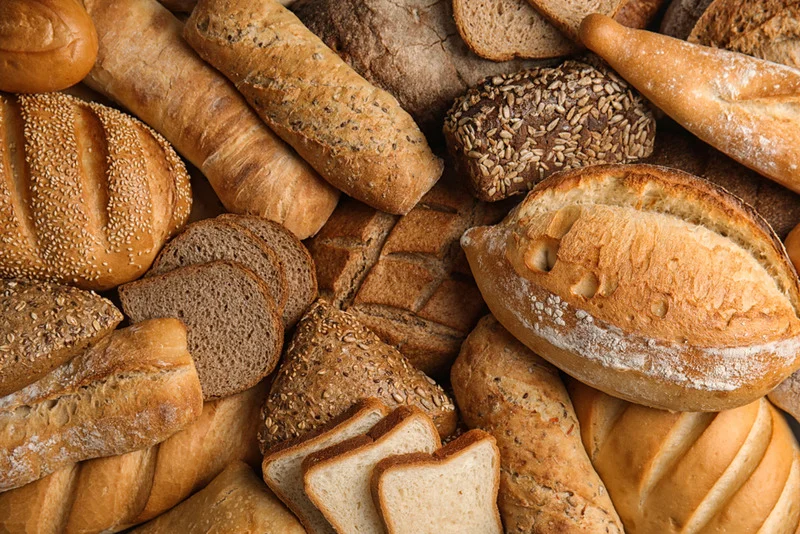Bread, in its myriad of forms, is a staple food item in cultures worldwide. This article provides insight into the types of bread and their multifaceted uses, as well as the science and culture behind these delicious creations.
The Science of Bread Making
From the crusty baguette to the fluffy brioche, each type of bread has its unique makeup. The science of bread-making revolves around ingredients and the fermentation process.
Basic Ingredients: At its core, bread is made up of flour (Here, you can find “How to Make Bread Flour at Home Easily and Quickly“), water, and often yeast. The variety in bread types emerges from the combination and proportion of these ingredients.
- Fermentation & Flavor: Yeast plays a pivotal role. As it ferments, it releases gas which gives bread its airy texture. The fermentation process also contributes to the unique flavor of breads like sourdough.
Different Bread Types & Their Origins
Leavened Breads
Breads that rise and expand owe it to leavening agents like yeast or baking powder.
- Sourdough: Known for its tangy taste, sourdough originates from ancient Egypt. The natural fermentation of dough gives it a characteristic tang.
- Baguette: The French pride, this bread has a crispy crust and soft interior. Ideal for sandwiches, french bread pizza, or just butter.
- Ciabatta: A rustic Italian bread with an airy texture, perfect for paninis.
Unleavened Breads
Without leavening agents, these breads are dense and flat but just as delicious.
- Tortilla: In Central America’s contribution to bread, tortillas are versatile and form the base for many dishes.
- Naan: Soft and fluffy, naan is an integral part of many Indian meals.
- Matzo: Symbolic in Jewish traditions, this flatbread is crisp and cracker-like.
Sweet Breads
For those with a sweet tooth, these breads are both meals and desserts.
- Brioche: A French marvel made with lots of butter and eggs. Its richness is unparalleled.
- Challah: This braided beauty is Jewish in origin and is often sweetened with honey.
- Panettone: Italian Christmas isn’t complete without this sweet, fruity bread.
Global Breads: Tracing Their Journey
Breads are like stories; each carries a piece of history from its place of origin.
- Focaccia: Ancient Rome’s gift, it’s an olive oil-rich flatbread often adorned with herbs.
- Roti: A staple in South Asia, this bread goes well with almost any curry.
- Pita: Middle Eastern origins, it’s widely used as a pocket for falafel or gyros.
- Injera: Ethiopia’s sour, spongy bread which complements their spicy dishes.
- Dosa & Idli: South India’s treasures are made from fermented rice and lentil batter.
Breads Beyond Meals: Unexpected Uses
Surprisingly, bread isn’t confined to dining tables.
- Crumbs: Old bread gets a new life as breadcrumbs for dishes like meatballs (Recipe of meatballs) or as a crispy topping.
- Thickeners: Bread, especially rye, can be used to thicken soups or stews.
- Bread Bowls: A novel way to serve soups or dips directly in a hollowed-out loaf.
Ingredients Decoded: What Goes Into Our Bread?
Behind every loaf lies a meticulous choice of ingredients.
- Rye Flour: Gives a deep, rich color and slightly sour taste to bread.
- Eggs & Butter: Responsible for the rich, soft texture of brioche and challah.
- Molasses: Pumpernickel owes its dark color and sweetness to this.
- Soda & Buttermilk: Integral for soda bread, providing the rise and tang, respectively.
Caring for Your Bread: Maximize Freshness
Fresh bread is a joy; here’s how you can prolong that experience.
- Avoid Plastic: Breads like baguette or ciabatta need to breathe; store in paper or cloth.
- Revive Stale Bread: Sprinkle water and reheat to bring back some freshness.
- Bread Bins: These traditional containers maintain a bread’s crust and interior texture.
Bread Pairings: Elevating Everyday Meals
The right bread can turn a meal into a feast.
- Cheese & Wine: A crusty French baguette, brie, and a glass of red wine.
- Curries: Soft naan or rotli elevates the spiciness of Indian curries.
- Salads: Focaccia croutons add a crunchy texture to fresh greens.
Healthy & Alternative Breads
With changing diets and awareness, these breads cater to specific needs.
- Sprouted Grain Bread: Uses whole grains that have been sprouted, making it a nutrient-dense choice.
- Gluten-Free Breads: For those with gluten sensitivities, these use alternatives to wheat flour.
- Rye Bread: Made with rye flour, it’s dense with a slightly sour taste.
The Uses of Various Breads in Meals
Bread isn’t just a side; it’s often the star of the meal.
- Breakfast: Toasted sourdough (Readmore “Best ways to toast bread in Oven, challah french toast, or a simple buttered baguette to start the day right.
- Main Course: Open sandwiches on rye, naan pizzas, or tortilla wraps.
- Desserts: Bread pudding made with brioche or cinnamon toast.
Storing Breads: Tips & Tricks
To maximize freshness and flavor, it’s essential to store bread correctly.
- Storing for Freshness: Keep bread in a cool, dry place. Some breads, like sourdough, last longer than others.
- Freezing: For longer shelf life, freeze bread. It retains flavor and freshness when thawed.
Frequently Asked Questions
How can stale bread be reused in cooking?
Old bread can be repurposed as breadcrumbs for dishes or as croutons for added texture in salads.
Why is rye flour significant in bread-making?
Rye flour gives the bread a rich color and a slightly sour flavor, often used in breads like pumpernickel.
What role do eggs and butter play in certain breads?
Eggs and butter contribute to the rich and soft texture found in breads like brioche and challah.




